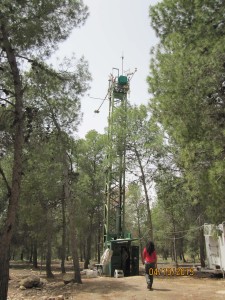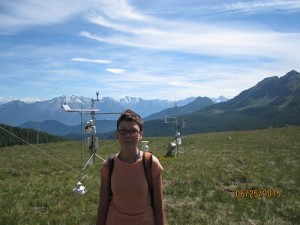Inspired by Ray Leuning’s lecture on ‘flux towers I have seen’ at the Colorado Flux short course, I thought I’d offer a contribution to the new FLUXNET blog with a short essay on the flux towers I have had the privilege to visit the past two years during trips to meetings and while on sabbatical in Europe.
We intend to use this blog as a replacement to the newsletter that was published in the past. So it will become a vehicle for groups to share information on progress at their sites, new findings and on general characteristics of what they are studying and the unique attributes of their study. We hope this first blog post will catalyze and recruit groups to submit short and concise summaries and narratives of ongoing work at their sites that can be shared among the community.
As a micrometeorologist, I relish the opportunity to see a cross section of sites across the network . I always find visits instructive and informative to get a better gauge on issues like topography, fetch, system setup and to learn more about the different ecosystems and climate spaces that we are studying as a group.
I’ll start this essay with Eurospec meeting in Trento, Italy (November, 2013). We had a field trip to the Monte Bondone alpine pasture, run by Damiano Gianelle, Matteo Sottocornola and Barbara Marcolla. For me it was fascinating to see this region and site since my grandfather was born and raised one valley over (the Valtellina) and farmed similar pastures. I must confess this was a beautiful alpine pasture, like ones you see in movies, like Sound of Music. This site is one of the better instrumented grassland sites in terms of automated hyperspectral reflectance system, bringing an additional and unique contribution to the core set of flux and meteorological measurements found across the network. Here there are many opportunities to merge flux data and hyperspectal data to study phenology and photosynthetic capacity of the land.

Figure 1 Monte Bondone field site in Italian Alps, near Trento
The AsiaFlux meeting in the Philippines (August, 2014) afforded me the opportunity to visit the rice tower of Maricar Carmelito Alberto at IRRI. Since we have a companion rice tower in California, it was important for me to see how rice was grown in Asia. Rice cultivation is a key producer of methane, so this site brings a subset of methane measurements to our network. Here the colleagues are making long term carbon dioxide and methane flux measurements over managed rice and are testing ideas like alternate wetting and drying as a management method to reduce methane emissions.

Figure 2 Eddy flux system at IRRI, Los Banos, Philippines, featuring an open path methane sensor.
During the summer of 2014, I had a fellowship to spend 10 days at the Czech Academy of Science in Brno and my local hosts (Michal Marek, Marian Pavelka, Ladislav Sigut ) brought me to visit their growing network of flux sites. The first field trip was to the long term site spruce site of Bily Kriz, which started during Euroflux.

Figure 3 Bily Kriz flux tower
While this site is on challenging terrain, the local investigators have festooned the site with a large network of soil and stem respiration chambers to provide independent measurements of ecosystem respiration. I was impressed with the chamber systems and found that these were some of the best designed and constructed soil and stem chambers I have ever seen. More of us should use the Czech design. With this system of independent efflux measurements they are better able to understand biases of night fluxes in rugged terrain. The other great thing about this site is that there is an inn, several hundred meters from the tower, which serves fantastic local Czech beer.

Figure 4 Stem respiration system at Bily Kriz, Czech Republic
The Czech team was recently awarded funding to construct and instrument an ICOS Tower. As a micrometeorologist having the opportunity to climb a 250 m tower and view the landscape was exhilarating. The landscape looks a lot like Nebraska where I did my Ph.D. work, and is the home of a large population of Czech immigrants; I can see why now. We also had the opportunity to visit Austerlitz, the location of the famous Napoleonic battle in the 1800s.

Figure 5 The Czech ICOS tall tower
Finally, I was able to visit their new deciduous forest site on a flood plain near the Austrian border close to Lanžhot. Having worked on deciduous forests in Tennessee on undulating terrain, I found this site ideal. It was flat with extensive fetch. Plus a suite of greenhouse gas sensors (CH4, N2O, CO2) are installed to study the effects of seasonal flooding on the metabolism of the forest and greenhouse gas budget. We look forward to the new data that will emerge from this site. It should be of high quality with minimal biases.
During the winter of 2015, I was on sabbatical and had a fellowship to spend a month at the Wageningen University, working with Jordi Vila. While in house I had the opportunity to visit the Loobos flux site of Bart Kruijt, Cor Jacobs and Jan Elbers. This is a scots pine forest in central Netherlands. Having been established in 1997, it is among the longest running sites in FLUXNET, so it is a great venue to understand interannual variability of fluxes. This team has tested novel ways to power the system, like with fuel cells. As flat as the Netherlands is considered to be, this site is on a glacial moraine so it was hillier than I expected. On the other hand, the fetch is large, despite the patchy nature of much of the Netherlands.

Figure 6 Cor Jacobs, Bart Kruijt and Jan Elbers at the Loboos site.
Students of micrometeorological history and theory will be familiar with the Dutch tall tower at Cabauw. This site is on the polders of the Netherlands; now this is a flat site!. Located there is a tall (213 m) tower with a suite of meteorological and greenhouse gas measurements, that are readily available on the internet (http://www.knmi.nl/kodac/ground_based_observations_climate/cabauw.html), and a shorter flux tower over the grassland. This was a great example of a team that is sharing their data, on a real time basis and can be a model for many other sites. It should be an ICOS site, but unfortunately the Dutch funding agencies is not supporting it as so. The shorter flux tower is sited near by and interpretation of this site can profit from information on the development of the planetary boundary layer and long term weather and climate measurements.

Figure 7 Jordi Vila and Fred Bosveld at the Cabauw flux tower site
After my sojourn in the Netherlands, it was off to Spain for a workshop in Granada. While there, I contacted the local PI, Andy Kowalski and he and his team took us to visit their Almeria site, on the way to some wonderful paella near the beach. This site was profiled in the FluxLetter and is at the drier edge of the gradient of sites in Europe and in the FLUXNET universe and has been the subject of some interesting exchange with carbonates in the soil.

Figure 8 The Spanish Llano de los Juanes site near Almeria, Penolope Serrano-Ortiz
In April, I had the opportunity to visit Dan Yakir at the Weizmann Institute in Israel and go to the Yatir field site, which was profiled in the FluxLetter. This is a pine planation near the desert and receives about 200 mm of rain per year. This site has been instrumental in a series of studies comparing the effects of trees and no trees on climate and energy exchange. The team is also using tunable diode laser spectrometers to assess photosynthesis independently through measurements of carbonyl sulfide (COS).

This July, I had the opportunity to revisit the Italian Alps, near the French border, as part of a Land Atmosphere Shortcourse. Marta Galvagno was kind to host me to a visit of her FLUXNET sites association with Torgnon. Marta has two sets of interesting studies. One is over an abandoned pasture in the high alpine region. This is a well instrumented site with soil respiration chambers, phenocams and hyperspectral reflectance, in one of the most beautiful spots I have ever visited. Already, one is seeing a transformation of the pasture as grazing has been excluded. Her second site is in a larch forest with a 20 m tower. The land is rugged, but they have used this site in advection studies and the drainage may be regular and consistent. Lot to learn from this deciduous conifer forest canopy. The other companion in FLUXNET is in Japan.

Post script
While this is a survey of sites I have seen most recently, over the years I have also been able to visit FLUXNET sites at Bordeaux, France; Hyytiala (of course), Finland; Roccarespampani, Italy; Hainich, Germany; Stubai Valley, Austria and Takayama, Japan, as well as a number of US and Canadian sites and non FLUXNET field sites in Wagga Wagga Australia and near Christchurch, New Zealand.
As can be seen through this short narrative, the network contains a broad range of study sites with many diverse and innovative investigators bringing new and uniques ways to understand the function and metabolism of ecosystems through the central lens of measuring long term fluxes of carbon dioxide and water vapor. I look forward to visiting more sites in the future.
